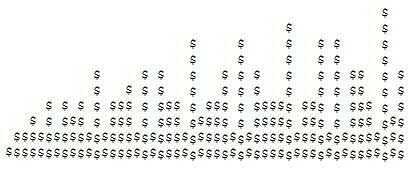46
6
For any positive integer k, let d(k) denote the number of divisors of k. For example, d(6) is 4, because 6 has 4 divisors (namely 1, 2, 3, 6).
Given a positive integer N, display a "skyline" in ASCII art using a fixed character, such that the height of the "building" located at horizontal position k is d(k) for k = 1, ..., N. See test cases below.
Rules
- Any non-whitespace character may consistently be used, not necessarily
#as shown in the test cases. - The algorithm should theoretically work for arbitrarily high
N. In practice, it is acceptable if the program is limited by time, memory, data-type size or screen size. - Horizontally or vertically leading or trailing spaces or newlines are allowed.
- Input and output can be taken by any reasonable means.
- Programs or functions are allowed, in any programming language. Standard loopholes are forbidden.
- Shortest code in bytes wins.
Test cases
N = 10:
# # #
# # ###
#########
##########
N = 50:
#
# #
# # # # # #
# # # # # #
# # # # # # # # # # ## # #
# # # # # # # # # # # ## # #
# # # # ### # ### # ### # ##### ### # ### # #
# # ### # ### # ### ##### # ##### ### # ### ###
#################################################
##################################################
N = 200:
#
#
# # #
# # # #
# # # # #
# # # # #
# # # # # # # # # # # # # # # # # # #
# # # # # # # # # # # # # # # # # # #
# # # # # # # # # # # # # # # # # # # # # # # #
# # # # # # # # # # # # # # # # # # # # # # # # # # #
# # # # # # # # # # # # # # # # # # # # ## # # # # # # # # # ## # # # # # # # # # # # # # # # # # # ## # ## # #
# # # # # # # # # # # # # # # # # # # # # ## # # # # # # # # # ## # # # # # # # # # # # # # # # # # # ## # ## # #
# # # # # # # # # # ## # # # # # # ## # # # # ## # # # # # # # ### # ## # # # # ## # # # # # # ## # # # ## # ### # # # ## # ### ### # # # # ### # ## # #
# # # # # # # # # # # ## # # # # # # ## # # # # ## # ## # # # # # ### # ## # # # # ## # # # # # # ## # # # ## # ### # # # ## # ### ### # # # # ### # ## # #
# # # # ### # ### # ### # ##### ### # ### # ### ##### # ##### ### # ##### ### ##### ####### ### # ### # ### ####### ##### ### ##### # ######### # ##### ##### ### # ### ##### # ######### # ### # #
# # ### # ### # ### ##### # ##### ### # ### ##### ##### # ##### ### # ##### ### ##### ####### ### # ### # ### ############# ### ##### # ######### # ##### ##### ### ##### ##### # ######### # ### # #
#######################################################################################################################################################################################################
########################################################################################################################################################################################################




25 minutes and 10 seconds :-) – Luis Mendo – 2017-05-07T16:37:10.107
13I was reading other stuff in the meantime... I'll be faster next time. – Leaky Nun – 2017-05-07T16:37:48.660